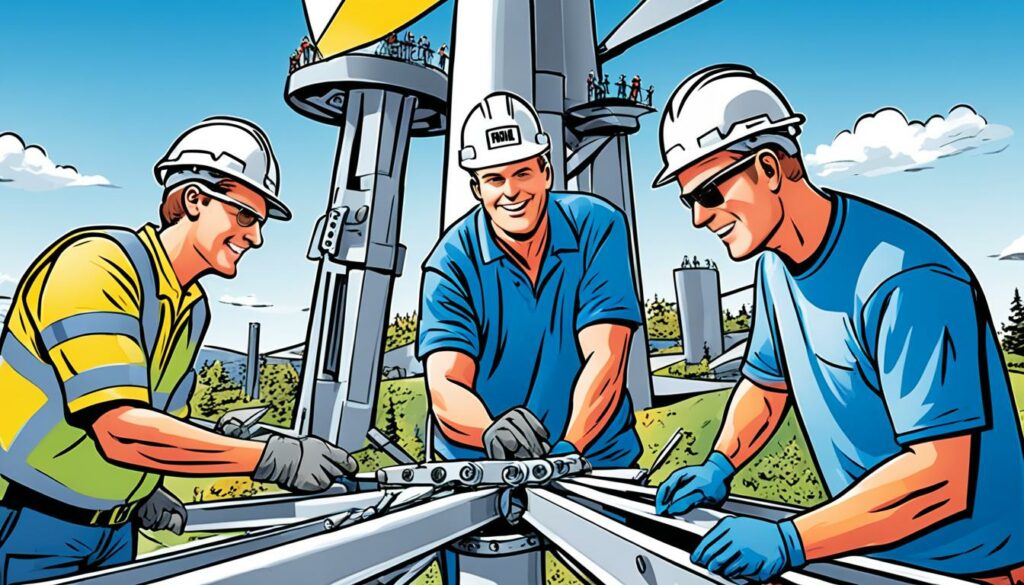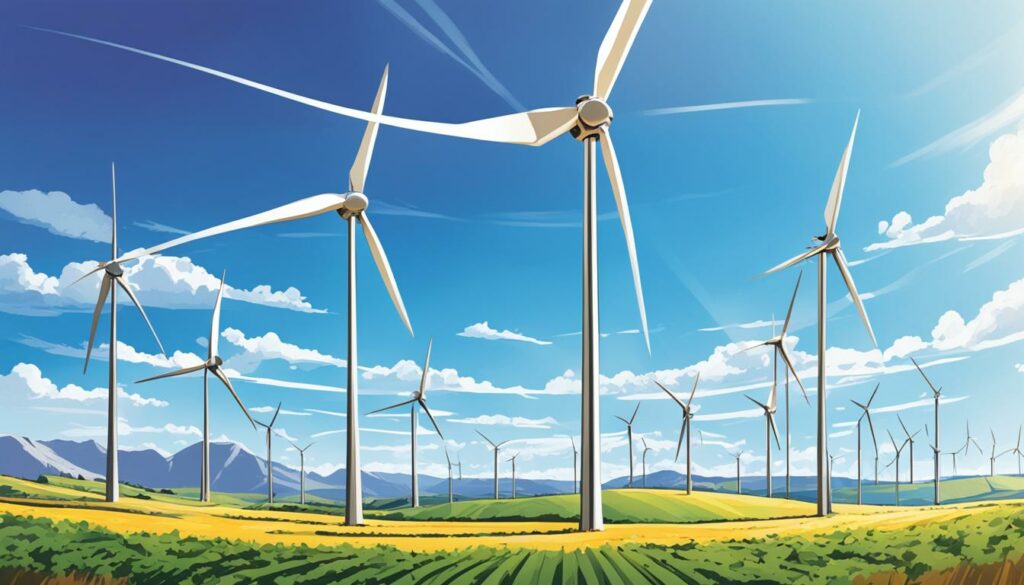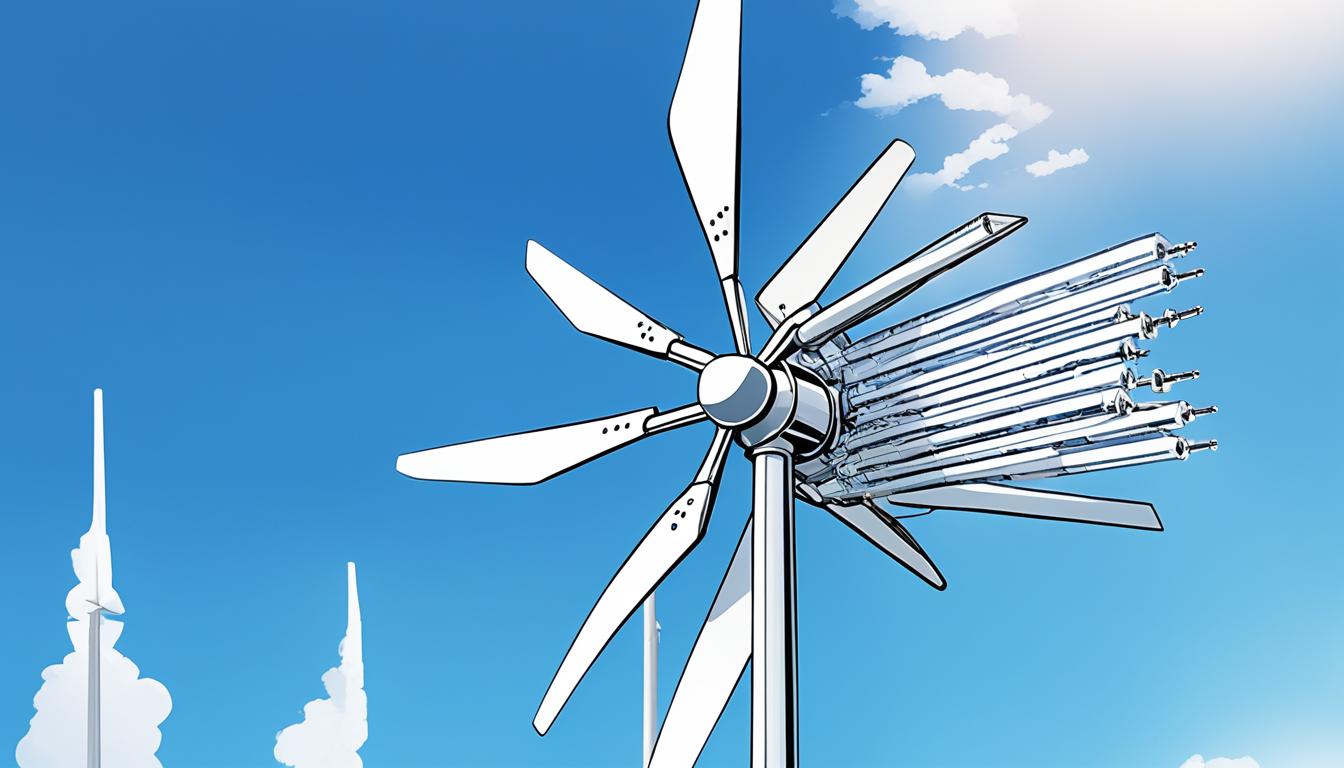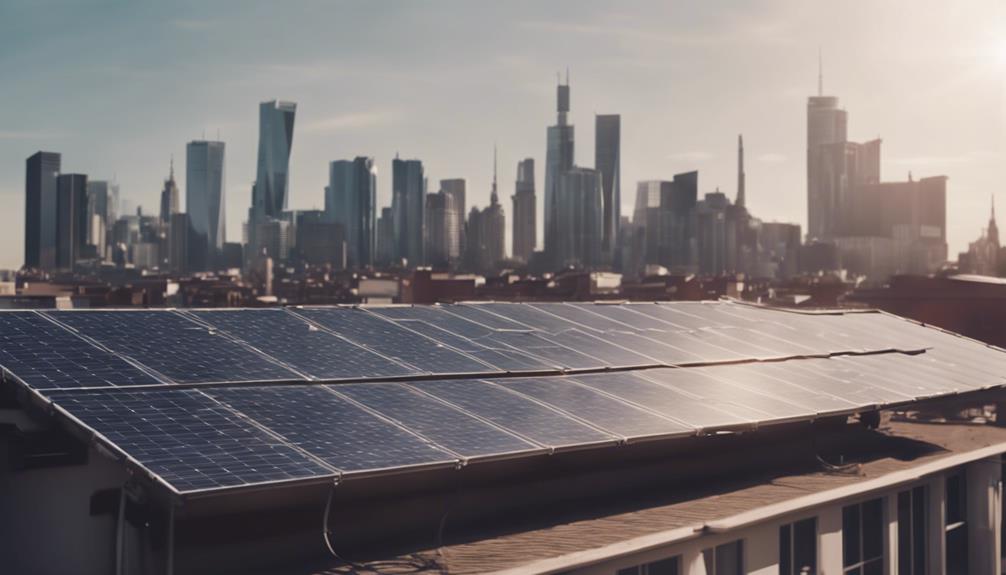Did you know wind turbines can power your light bulbs? That’s right! Wind energy is a clean, renewable power source. It’s growing in popularity lately. Nowadays, wind turbines aren’t just for big wind farms. They’re also made small for everyday use.
There are many different wind turbine kits out there. Each has its own perks and features. Whether it’s an educational kit for kids to learn about green energy or a small off-grid kit for camping, there’s something for everyone. You can get DIY kits to build your turbine. Or wind-powered lighting kits for light anytime outdoors or in emergencies.
Key Takeaways:
- Wind turbines can power light bulbs, offering a sustainable and efficient lighting solution (Ref1.).
- There are different types of wind turbine kits available, including educational kits, small off-grid kits, DIY kits, and wind-powered lighting kits (Ref1.).
- Wind turbine kits are suitable for various purposes, such as camping, cabins, emergency backup power, and educational activities (Ref1.).
Types of Wind Turbine Kits
Wind turbine kits come in many types to match various needs and interests. You can find one whether you’re teaching, living off the grid, or enjoy doing projects yourself. Each kit is tailored to suit different users perfectly.
Educational Kits: These kits are made to help with learning. They come with experiments and activities to teach about wind energy. For instance, the Wind Energy Science Kit2 includes different blades for trying out. It helps students learn about energy production and the physics behind it by testing with wind turbines2.
Off-Grid Kits: Off-grid kits help power up remote places. They include a wind turbine, a controller, and a battery for storing energy. These kits offer a green way to generate power where traditional sources can’t reach3.
DIY Kits: If you like building things, DIY kits are great. They provide all you need and teach you how to put together your own wind turbine. This way, you can make a wind turbine that suits your own needs3.
Wind-Powered Lighting Kits: These kits use wind energy to light places. They often come with an LED light, a turbine, and a controller. They’re a green solution for lighting your yard or garden path3.
Choosing a wind turbine kit helps the planet and reduces your need for standard energy. Pick the right kit based on your goal, whether it’s for learning, living off-grid, or a personal project.
Types of Wind Turbine Kits
| Type of Kit | Description |
|---|---|
| Educational Kits | Kits designed for learning purposes, including experiments and curriculum materials2. |
| Off-Grid Kits | Kits suitable for powering lights, charging devices, and running low-power appliances in remote areas3. |
| DIY Kits | Kits that provide components and instructions for building a personalized wind turbine system3. |
| Wind-Powered Lighting Kits | Kits designed to illuminate outdoor spaces using energy generated by a wind turbine3. |
Factors to Consider When Choosing a Wind Turbine Kit
Choosing the right wind turbine kit is essential for powering your lights. You should think about the location’s wind, the kit’s capacity, how much money you can spend, and how much care it will need.
To pick the best wind turbine kit, understand your area’s wind conditions. The kit’s effectiveness depends on how much wind energy there is. By checking average wind speeds and directions, you can find the right kit size. You might want to look at a local wind map or talk to an expert4.
Next, think about how many lights you need to power. Wind-powered kits come with a turbine, LED lights, and a controller. Make sure the kit can handle the number of lights and their power needs efficiently4.
Your budget is also key. Wind turbine kit prices change based on brand and features. Choose one that suits your budget and lighting needs. Look around to compare prices and payment plans4.
Don’t forget about maintenance. Wind turbines from Automaxx focus on efficiency and last a long time4. But, they still need regular checks to work their best. Consider how easy it is to maintain the kit and any extra costs.
In brief, when looking for a wind turbine kit for lights, consider your local winds, how many lights you have, the kit’s ability, how much you can spend, and upkeep needs. Understanding these points will help you find the best kit for a reliable and efficient wind-powered lighting system4.
The Importance of Acquiring a Generator
Getting a generator is key when using wind power for energy. It is a core part of a wind turbine, turning blade movement into electric power. You can make this easier by using specific motors, like those from Ametek, for your project.
The 99 volt DC motor from Ametek is a top pick for wind turbines. It’s known for being efficient and lasting long. But, you can find other good motor brands for this job too.
Having a generator in your wind turbine lets you use wind’s unlimited energy. This energy can light up streets in cities or power remote areas. It’s a fantastic way to use natural resources.
Using wind energy helps fight climate change by lowering harmful emissions. Wind-powered lights are a green choice over regular ones. They greatly cut down on greenhouse gases.
Wind power is also more budget-friendly compared to usual electricity sources. Wind-powered lights are cheaper to run once set up5. These turbines are not only cost-saving but also work efficiently for a long time. Just remember, they do need regular checks to keep running well.
For cities, wind-powered lights mean less reliance on traditional power sources. These lights are a stable source of light, especially in blackout-prone places5. Many cities are starting to adopt this technology because it’s a smart choice for street lighting.
To wrap it up, a generator is essential for using wind power in turbines. Ametek motors are great for this, along with other trusted brands. Wind energy is not just good for the planet but also for your wallet. Be a part of the shift towards wind power for a better, greener future.
Building the Blades
Building wind turbine blades can start with PVC pipe. This method is easier than crafting from wood. Black ABS pipe works too, turning into effective airfoils for the turbine6.
The first step is cutting and molding PVC pipe to the right airfoil shape. It’s flexible, letting you customize for any DIY project. Smoothing with sanding tools comes next, improving aerodynamics6.
Getting the airfoil shape right is key for a good turbine. It helps the blades lift and cut through air better. This way, the turbine catches more wind, and makes more electricity6.
The blade’s size and airfoil shape decide how much power you get. Bigger blades mean more electricity. This powers up the connected bulb more brightly6.
The simple turbine we talked about can make up to 1.5 volts. But, big electricity-generating turbines have extra parts. They use gearboxes to spin faster, producing more electricity6.
For the best blade design, you can test with a digital multimeter. It measures the power different blades make. This finds the design that gives the most electricity6.

| Date of the Event | Tags | Presenter Expertise |
|---|---|---|
| June 26, 2024 | ISO/IEC 42001, Artificial Intelligence, EU AI Act, ISO/IEC 23894 | Miriama Podskubova – Attorney at Law, specializing in commercial law, venture capital investments, IT, digital law, and cybersecurity |
| – | – | Callum Wright – Founder and Lead Consultant, with expertise in cybersecurity, privacy, and AI governance |
| – | – | Miriama Podskubova has over a decade of legal experience and is a certified data privacy professional in the European Union (CIPP/e) |
| – | – | Callum Wright, with over a decade of experience, has a background in security architecture, AI governance, risk consulting, and privacy management |
| – | – | Callum Wright’s experience includes roles in security architecture, AI governance, risk consulting, and privacy management across various industries |
| – | – | Callum Wright is experienced in leading technical project management teams, ensuring data privacy, and establishing ethical AI governance frameworks |
Constructing the Hub
Building a wind turbine requires a strong hub. This hub connects the blades and helps make electricity efficiently. You can make a sturdy hub by joining a toothed pulley and an aluminum disk. This setup connects the blades well to the hub and the hub to the motor.
The toothed pulley is key for a trustworthy hub. It links the blades securely when bolted to the aluminum disk. The hub plays a major role in capturing energy from the wind.
To make the hub, drill holes in the aluminum disk to match the pulley’s holes. Tapping these holes makes sure they line up right for the bolts. This step is essential for a secure hub.
Use strong bolts to fasten the pulley tightly to the disk. Any looseness can harm the turbine’s stability and power production.
The special design of the toothed pulley ensures a solid bond between the blades and hub. This lets the blades catch wind power and send it to the motor.
A well-made hub boosts your wind turbine’s performance. The aluminum disk forms a steady base, while the toothed pulley adds strength.
With the right building steps and materials, your hub can meet the wind turbine’s needs. This ensures good energy conversion and power output from the wind.

Making a good hub is crucial for a wind turbine. It keeps the blades attached and helps in efficient power creation. By using a toothed pulley and an aluminum disk, you get a hub that handles wind well and improves energy use.
| Statistical Data Reference | 7 |
|---|
Building the Turbine Mounting
Getting the wind turbine mounted right is key for its stability and energy output. The mount holds the motor and lets it face the wind. This boosts its efficiency and the power it can make. There are many ways to mount the turbine, depending on its size and type.
One easy way is using a piece of wood, like a 2×4, for the base. You can strap the motor onto the wood tightly. This method is simple but makes sure the turbine is stable. It also makes installation and upkeep easier.
To make sure the turbine faces the wind, add a tail to the motor. This tail is often made of light aluminum and works like a vane. It keeps the turbine aimed right, stopping it from getting off track. This lets it make the most energy.
The design of the mount and tail must handle different weathers to make the turbine last longer. Think about your local wind patterns and any area rules. For instance, some places limit how tall a residential turbine can be to 35 feet. Knowing these rules is important to follow local guidelines.
Wind turbines for homes usually make about 52 to 55 decibels of noise. This level of noise is pretty low. It means they can be used in living areas without bothering people much. This lets us use clean energy at home without making too much noise.
The power a wind turbine makes varies with its size. For homes, turbines range from 400 watts to 100 kW. But, for a turbine to meet a home’s electricity needs, it should be between 5 to 15 kW. The maker of the turbine can tell you how much energy it might make based on your local winds. This information helps in picking the right turbine and setting it up properly8.

A well-made mount makes sure your wind turbine stands strong. No matter the size of your project, the right mount is critical. It helps use wind power effectively, providing clean energy for homes or businesses.
Designing the Tower Base
The tower base keeps a wind turbine stable and durable. It supports the entire structure so it can face wind and weather. When creating the tower base, considering key factors is vital for performance and safety.
The design includes a 2-foot diameter plywood disk. This disk is the foundation for the tower. It keeps the structure steady and stops it from falling during use. The plywood must be strong and treated for outdoor use.

To build the tower base, a U-shaped structure from 1-inch pipe fittings is used. This structure is the main support. It’s attached to the plywood base with sturdy fasteners to stay stable. The pipe fittings allow for easy take-apart for transport or fixes.
Stability of the tower base is key in windy or unstable soil areas. Steel stakes, driven into the ground and connected to the U-shape, anchor the tower. These stakes must be long and thick enough to support well and keep the tower steady.
Design also focuses on easy install and care. A hinge made with a 1 1/4-inch Tee is part of the base. This hinge helps raise and lower the tower easily. This makes setup and maintenance quicker and easier.
With a thoughtful base design, wind turbines work well and last. They make clean energy from wind. A good base lets the turbine work smoothly, making more power safely.
| Key Components of a Well-Designed Tower Base |
|---|
| 2-foot diameter plywood disk |
| U-shaped assembly made of 1-inch pipe fittings |
| Steel stakes for anchoring |
| Hinge with a 1 1/4-inch Tee |
References:
- 9 The text explains how wind turbine making is booming in the U.S. and worldwide. This shows more people are using wind for power. To build a wind turbine, you need things like PVC fittings, PVC pipe, alligator clips, balsa wood, a Wind Turbine Generator, Hook Up Wire, and Poplar Dowels. Building the tower base involves PVC parts like 90 Degree fittings, T fittings, and pipes of different lengths, showing a practical way to learn about wind turbines.
- 10 Total project time: 45 minutes to 1 hour. Black paper size: about 20 x 20 inches. Tower height: about 10-15 inches, with a 2-inch top and 4-inch bottom opening. It has 3 air inlets at the bottom, each 2 inches by 0.5 inches. Propeller blades bend down at about 45 degrees. Propeller’s diameter is about 3 inches. Needle sticks out about 1.5-2 inches from the cone. Watch the tower for 2 to 5 minutes with the lamp on, then 5 to 10 minutes after turning it off. White paper can change how fast the propeller spins.
Building the Charge Controller
A wind turbine needs a charge controller to manage its power. You can buy one or make it yourself to save money and customize it. Creating your own controller lets you understand your system better.
There are online guides with diagrams and steps for making a charge controller. These guides explain each part’s role, helping you learn how it works.
Components and Circuitry
A wind turbine charge controller has parts like diodes, resistors, and transistors. They work together to safely charge batteries. Diodes ensure current flows correctly. Resistors manage voltage, and transistors switch current flow.
Choosing quality parts is key for a good controller. Durable components ensure your controller works well with your wind system.
Benefits of Making Your Own Charge Controller
Building your controller can save money and lets you tailor it to your needs. You can design it for your turbine’s power and add features like data logging.
This project also teaches you about control systems. Such knowledge is helpful for future troubleshooting or upgrades.
| Component | Function |
|---|---|
| Diodes | Enforce current flow in one direction |
| Resistors | Control voltage levels |
| Capacitors | Stabilize electrical signals |
| Transistors | Act as switches to control current flow |

Making a wind turbine charge controller saves money and deepens your understanding. With the right materials and some learning, you can make a controller that keeps your system running smoothly.
“Building your own wind turbine charge controller offers the benefits of cost savings, customization, and a valuable learning experience.” 11
STEM Toy: Build Your Own Wind Turbine Kit
The Build Your Own Wind Turbine Kit is a fun STEM toy. It teaches middle and high school students about renewable energy. Kids get to build a wind turbine and learn about wind power and energy concepts.

This wind turbine kit is made for learning. It comes with a 14” tall turbine frame of wood and PVC pipe. Students use a digital multimeter to learn about electric properties.
Students can do seven different experiments with this toy. They can study wind energy, the turbine’s power output, and adding solar cells for more power.
The kit sparks creativity and invention. It has different blade designs and extra materials for more experiments.
The kit includes motors, propellers, wires, a capacitor, and colorful LEDs. These parts let students experiment with turbine blades, capacitor charging, and electric circuits.
The 26-page manual helps students build their turbine correctly. It covers the basics of wind energy and sustainable resources in detail.
Interested learners can look at the sample manual to see what the kit teaches.
This kit helps kids learn important STEM skills and about renewable energy. They get hands-on experience by building a turbine. It inspires them to care about nature and sustainable resources.
Conclusion
Using wind turbines to make electricity is both cost-effective and good for the environment. You can go for a wind turbine kit designed by experts. Or you might even take on a do-it-yourself project. The value of using the wind for energy is clear. This is shown by the 3,165 reviews for the project “Harness Wind Turbine to Power Your Light Bulbs”13.
Wind power is easy to get to and doesn’t cost much. It also helps us rely less on old energy sources like fossil fuels. With a project that costs less than $20 and only takes 2-5 days to finish13, anyone can help add to renewable energy. You will need about 20 big paper clips, 30-40 sturdy straws, 3 small washers, a drill bit, and around 50 marbles13.
Studies on wind turbines show they can create a lot of power. For example, a certain wind turbine got a power factor of 0.2114. And, a special street light system used both a PV panel and LED bulbs for good light14. Adding a storage system lets us use energy more efficiently14.
Governor Patrick has set a goal for 2020. He wants to have 2,000 megawatts of wind energy15. While we should be careful with exact numbers, wind energy has been a steady source15.
As we look for cleaner electricity methods, wind power stands out as a great choice. It helps us hope for a better and greener future for everyone.
References:13Source: Statistics from link 114Source: Statistics from link 215Source: Statistics from link 3









